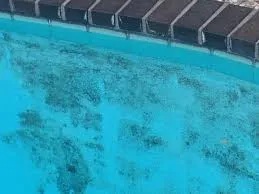Picture this: you step out into your backyard on a sunny day, ready to take a refreshing dip in your pool, only to be met with an unwelcome sight – black algae infesting the walls and floor of your once pristine oasis. Black algae, a common nuisance in swimming pools, can be a stubborn problem to tackle. In this post, we will delve into the causes of black algae growth and explore effective strategies to eradicate it from your pool, restoring its crystal-clear waters.

Understanding Black Algae:
Black algae, also known as blue-green algae or cyanobacteria, are tiny microorganisms that thrive in warm, sunny conditions. Contrary to their name, black algae appear more as dark green or blue-green clumps or spots that cling to the surfaces of a pool, particularly in areas with poor circulation and inadequate sanitation. These algae have a protective outer layer that shields them from common pool treatments, making them notoriously difficult to eliminate.
Causes of Black Algae Growth:
Several factors contribute to the growth of black algae in swimming pools:
1. Poor Water Circulation: Inadequate circulation allows algae spores to settle and proliferate in stagnant areas of the pool.
2. Inadequate Sanitation: Insufficient chlorine levels or ineffective sanitation practices create an environment conducive to algae growth.
3. pH Imbalance: Fluctuations in pH levels can create conditions that promote algae growth.
4. Lack of Maintenance: Neglecting regular pool maintenance, such as brushing and vacuuming, can lead to algae infestations.
Getting Rid of Black Algae:
While black algae may present a formidable challenge, with persistence and the right approach, you can reclaim your pool from its clutches. Here are some effective strategies to eliminate black algae from your swimming pool:
1. Brushing: Use a stiff-bristled brush to scrub affected areas vigorously, breaking through the algae’s protective layer.
2. Shock Treatment: Superchlorinate your pool with a high dose of chlorine to kill algae spores and break down their defenses.
3. Algaecide: Choose a specialized algaecide formulated to target black algae specifically. Follow the manufacturer’s instructions for best results.
4. Manual Removal: Vacuum the pool thoroughly to remove dead algae and prevent further growth.
5. Maintain Proper Water Chemistry: Regularly test and balance your pool’s pH and chlorine levels to prevent algae from returning.
Prevention is Key:
To prevent future black algae outbreaks, establish a routine maintenance schedule that includes regular brushing, vacuuming, and water testing. Ensure proper water circulation and sanitation to create an environment that discourages algae growth. Additionally, consider using a quality algaecide as a preventive measure to keep black algae at bay.
Conclusion:
Dealing with black algae in your swimming pool can be a frustrating ordeal, but armed with the right knowledge and strategies, you can effectively combat this persistent foe. By understanding the causes of black algae growth and implementing proactive maintenance practices, you can enjoy a clean, algae-free pool all season long. Remember, consistency is key in the battle against black algae – stay vigilant, and your pool will remain a sparkling oasis for you to enjoy.




